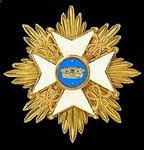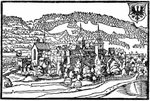I was recently asked to do the flags of these two units so am posting them here in case there is anyone else keen to respresent them on the tabletop!
When Frederick finally forced the surrender of almost the entire Saxon army near Pirna on the 17th October 1756, "he announced that he intended to incorporate the Saxon regiments as intact units into the Prussian army". "The Saxon troopers were scattered among the Prussian horse but altogether ten regiments of Saxon infantry were taken over entire and shared among the generals .... Frederick had certainly counted on some individual desertions from the ex-Saxon units, but over the course of the following months the Saxon troops defected by entire battalions at a time. "Most of the battalions in question, after they had chased their commanders away or shot them, withdrew with full military formalities. They took with them their bread and ammunition carts, their regimental chests and all the other items of their baggage, and they either marched to Poland or broke through to the French". By the end of 1757 Frederick was left with just three regiments of infantry and one grenadier battalion, and even these were mostly composed of recruits who had been raised individually in Saxony.
Frederick would have done much better to split the Saxons up and incorporate them among his reliable old regiments, as Winterfeldt had suggested. It is difficult to understand why Frederick chose the other course. Perhaps he believed, like Prince Moritz of Anhalt-Dessau, that the Saxons would be eager to fight under a Protestant king or perhaps he was blinded by his inveterate hatred of all things Saxon... This episode remains among his worst miscalculations as a man-manager..." Duffy, The Army of Fredrick the Great.
IR55 (the former Saxon Fürst Lubomirsky Infantry ) seems to have been the only ex-Saxon regiment which saw active service in the Seven Years War. At first under the command of Major-General Baron C. von Hauss, it was commanded by L. P. von Roebel from December 1760 to 1763. At first as garrison at Halle, the regiment fought in the battle of Kunersdorf on 12th August 1759. As part of Finck's command, it suffered heavy losses; Duffy, Army of Frederick The Great 1st Edition shows around 40% casualties. One battalion of the regiment was part of a small isolated force under Major-General Dierecke at Meissen which was overwhelmed and captured by a much larger Austrian force on 4th December 1759. The three battalions of which it was part were isolated on the right bank of the Elbe and other Prussian troops were unable to help them. The regiment served in 1760 in Saxony and one battalion fought at Strehla on 20th August. It was again in Saxony in 1762 and one battalion took part in the surprise attack on Doebeln on May 12th. It was then in Bohemia with Seydlitz, fought at Teplitz on August 2nd and was part of the reserve at Freiberg on October 29th. (Most of the operational information from Kronoskaf.)
Duffy (Army of Frederick the Great) says: "Badly hit at Kunersdorf, where Major Ewald v. Kleist (the poet) was mortally wounded. The survivors captured at Maxen. The regiment was restored, but disbanded, after the peace, the men going to IR no.36."
And this was the somewhat stripped down and simplified uniform:
IR56 (the former Saxon regiment Prinz Friedrich August) spent most of the war in garrison at Lübben and Guben. Kronoskaf says "On March 28 1757, the second battalion of the regiment mutinied. The first battalion did the same on March 29. They both escaped to Poland. However, the regiment was soon re-established with new levies. The regiment seems to have continued to assume garrison duties till the end of the war."
Duffy (Army of Frederick the Great) says: ""Restored after a mass desertion in March 1757. After the peace it took the place of the disbanded IR no. 32."
And this was the uniform:





















